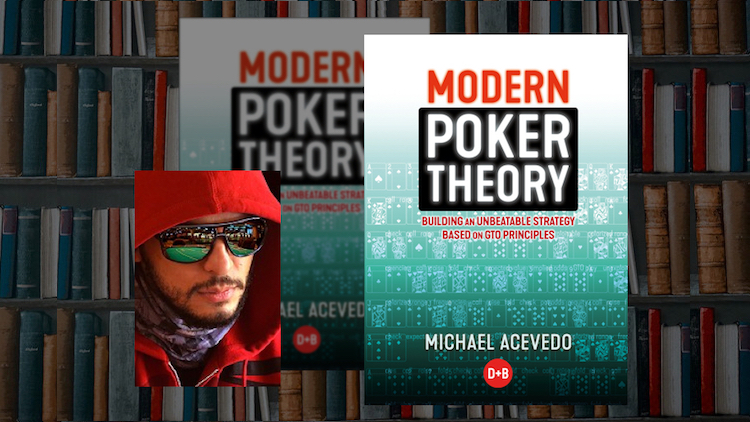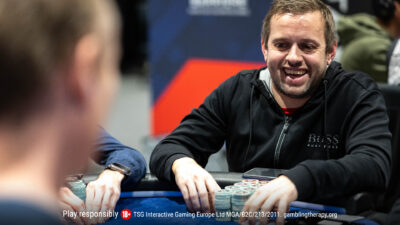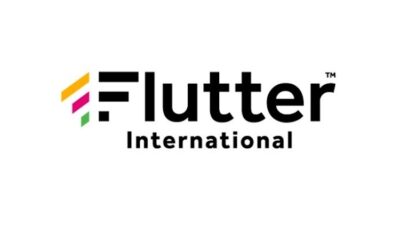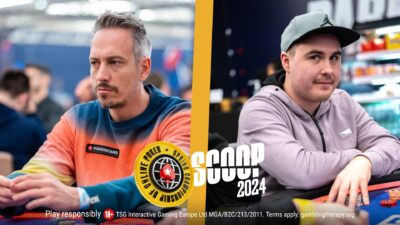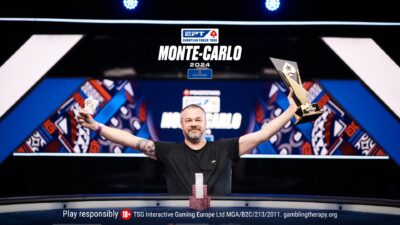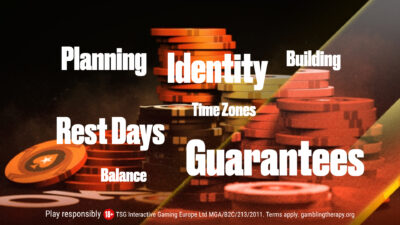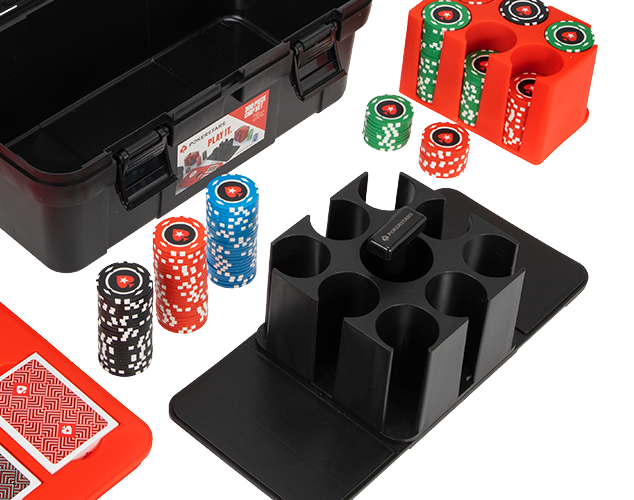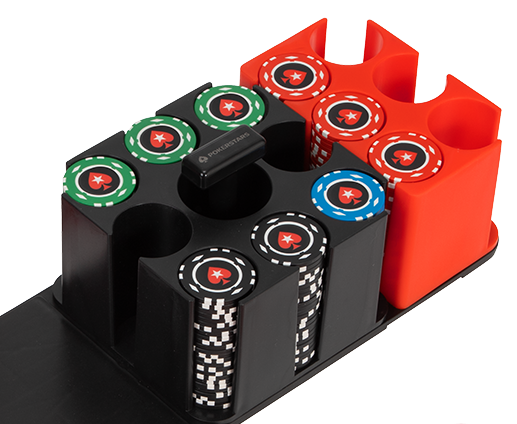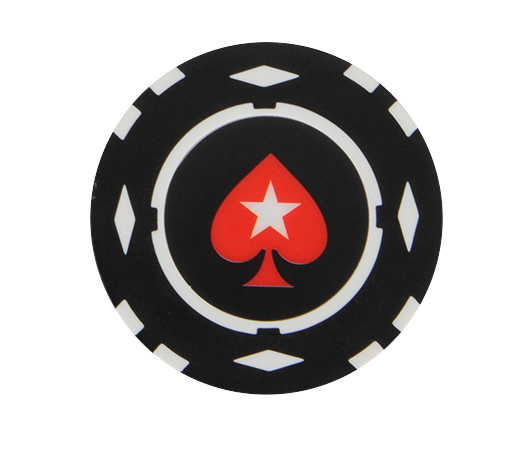Published last year, Modern Poker Theory: Building an Unbeatable Strategy Based on GTO Principles by Michael Acevedo has proven to be one of D&B Publishing‘s more popular strategy titles. As the title suggests, it is a great one for those seeking to understand game theory optimal play (GTO) and to apply ideas related to GTO play at the poker table.
Modern Poker Theory is the result of many thousands of hours of research by Acevedo using some of the most advanced poker software tools available.
Understanding GTO is fundamental to being able to make accurate poker decisions and being able to exploit players who don’t. Modern Poker Theory uses modern poker tools to develop a systematic approach to the analysis of GTO. It organizes the ideas and concepts in an intuitive manner that is totally focused to practical applications.
 Michael Acevedo at the 2017 PokerStars Championship in Panama
Michael Acevedo at the 2017 PokerStars Championship in PanamaAcevedo presents his discussion in three parts. “Part One: The Elements of Poker Theory” focuses on basic poker concepts and game theory’s relevance while also showing how to use various modern poker software. Then “Part Two: Pre-Flop: Theory and Practice” and “Part Three: Post-Flop: Theory and Practice” separately discuss in-game situations while demonstrating how a knowledge of game theory optimal play can apply in each.
The following excerpt comes from “Part Two: Pre-Flop: Theory and Practice.” Specifically it appears in the section titled “The Theory of Tournament Play” that covers topics like variance, tournament metrics, bankroll management, game selection, the mental game and “the tournament life.”
In the discussion below, Acevedo offers some concrete advice about how to play tournaments in a way that lessens your variance while increasing your profits.
Should you put in more volume? Move up stakes? Study more and play less? If you’re asking these questions, Acevedo has some answers for you.
Decreasing Variance and Increasing Profitability in MTTs
The two main ways of decreasing variance while increasing your profitability in MTTs are to increase your Average ROI and to increase your volume. First, you should focus on increasing your Average ROI because it’s pointless to put in a lot of volume if you can’t even beat the games, so you should only increase your volume once you are certain you can beat the games you want to play.
Another way to increase profitability is to play higher stakes, although this will also increase your variance because, in general, the higher the stakes, the tougher the games. So, you can expect your ROI to be reduced as you move up in stakes. Also, there aren’t nearly as many high stakes online tournaments as there are low-mid stakes tournaments, so the volume a high stakes online MTT player can put in on a yearly basis is limited and that increases variance. Playing fast/turbo tournaments can help increase volume, but the possible ROI in them is also lower than regular-speed games due to having less time to extract value from weaker opponents, with most of the play taking place pre-flop with shallow stacks. Bounty tournaments are good to reduce variance, but your EV in them is lower than regular MTTs because a portion of the prize pool is taken away for the bounties, and weaker players, who are less likely to win the tournaments, will capture some of that bounty pool by knocking out some players before busting. On the other hand, for these same reasons, bounty tournaments favor weaker players.
Increasing Your Volume
Live MTTs are particularly attractive as they offer higher ROIs than their similar buy-in online counterparts due to the softer fields. However, at the same time, variance is a lot higher in live MTTs compared to online because of the low volume. So, a good way to increase your volume is to play online poker (assuming online players play multiple tables and, in general, more games than live players).
For new players, I recommend a ratio of 50% play time and 50% study time. Gaining in-game experience is vitally important because there are many aspects of poker that can really only be learned by playing. So, for new players, volume isn’t about making money, but instead about getting proficient with the practical and theoretical aspects of the game and so the focus should be on study. However, for winning players I recommend a ratio of 80% play time and 20% study time. After a player’s ROI is high enough, putting in a lot of study time won’t have a high impact on their bottom line but, at the same time, if a player completely stops studying, their poker skills will stagnate while their opponents keep improving. Slowly but surely, they will become worse relative to the field, thus the need to continuously improve. My personal ratio for the last few years has been the opposite, 20% play time and 80% study time, which is not something I’d recommend to people who like winning money! I just happen to enjoy coaching and theory work, such as writing GTO books and articles, a lot more than I enjoy playing. Still, I plan on putting in a lot more volume in the near future, playing both live and online tournaments, as well as cash games.
Increasing Your ROI
The easiest way to increase your ROI is to play lower stakes which implies playing against worse opponents. The toughest way is to become better than your opposition. The tricky part is figuring out how to actually do it.
The first thing to do is to make sure you can win chips from your opponents. It’s tough to get deep in tournaments if you can’t accumulate chips by constantly making +EV decisions, so you need to know how to play the game well, which means learning about pre-flop and post-flop strategies at different stack depths, pot odds, equity and all the other concepts discussed in this book. However, as mentioned before, succeeding at tournaments requires more than simply being able to accumulate chips.
Tournaments are more of an art than a science. I have often seen cash game players talk down to top MTT players and even call them names such as “donkament players” and yet these same cash players are unable to thrive in MTTs themselves. Even I am guilty of having done this in the past, thinking that all that was required to crush the games was to learn GTO and that was the main reason I got so involved in poker theory in the first place. Of course, being a GTO wizard helps to play better poker, but there are a number of soft skills that top MTT players need to develop in order to succeed. These include the understanding of tournament life, money bubbles, the way the different stages of the tournament change equilibrium strategies, a deep understanding of population tendencies, not to mention live reads, tells, bankroll management and mental game.
It was while writing this book that I found the most important game theory concept and I’ll share it with you now.
GTO poker is not about balance, it is about exploitation. Equilibrium strategies arise when two players are maximally exploiting each other, thus there is no need for balance when your opponents are unaware of what you are doing or are incapable of counter-exploiting you even if they knew exactly what you are up to.
Even though this realization might seem superfluous, fully understanding this concept helped me change my mindset at its core. I used to try to play good poker, to play well. Now I’m just trying to run over my opponents. Tournament poker is all about exploitative play, and this is why guys like Daniel Negreanu and Phil Hellmuth are among the most successful tournament players in poker history, even though they are not necessarily the most versed in poker theory. Daniel can talk his opponents into checking down AA on Qxx when he holds top pair and Hellmuth can fold AK pre-flop vs. AA from a short stack while later running a crazy bluff against Jungleman, making him fold trips and giving him the King of the Hill title.
This is also the reason why Fedor Holz took the world by storm, winning all the high rollers and super high rollers before retiring to pursue other ventures. He said in an interview that he doesn’t think he is particularly talented at poker but he surrounded himself with very smart people and he became part of a great community that helped him improve his technical skills. What makes him different from other players in the German team is his ability to put the theory into practice, to adapt more optimally than his opponents and to exploit weaknesses.
The GTO principles and strategies discussed in this book can help players improve their game, avoid fundamental mistakes and make better decisions. However, there is more to winning in poker than just playing well. So, my advice to increase your ROI is to study poker theory but also focus on how to put it into practice. Study your opponents and never be afraid of making a bad play or looking stupid, just like Daniel, Phil and Fedor aren’t afraid to, even when playing the biggest games when the whole world is watching.
Modern Poker Theory is available in paperback and as an e-book at D&B Poker.
D&B Publishing (using the imprint D&B Poker) was created by Dan Addelman and Byron Jacobs 15 years ago. Since then it has become one of the leading publishers of poker books with titles by Phil Hellmuth, Jonathan Little, Mike Sexton, Chris Moorman, Lance Bradley, Martin Harris and more, all of which are available at D&B Poker.
Back to Top

